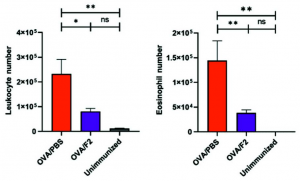A group from Graduate School of Pharmaceutical Sciences, Chiba University, Chiba has reported that Sialyl Lewis X (sLex) carbohydrate antigen could serve as a novel therapeutic target for allergic asthma with using a mouse asthma model.
https://www.ncbi.nlm.nih.gov/pmc/articles/PMC8471066/
It was thought that a positive feedback loop will exist in the progression of allergic asthma.
The initial part of the positive feedback loop might start from the inhalation of allergens, resulting in the activation of pathogenic Th2 cells in the lungs. The activated Th2 cells would then release Th2 cytokines including IL-5, IL-4, and IL-13. IL-5 is released into the peripheral blood to induce the maturation and proliferation of the eosinophil precursors in the bone marrow. IL-4 and IL-13 facilitate the class switching of B cells to release IgE, which binds to mast cells. After repeated antigen exposure, histamine is released by the mast cells to damage the epithelial cells and activate the alveolar macrophages to release the CCL11, which attracts the eosinophils to the tissue. Eosinophils would then be recruited to the asthmatic lung through interaction with its sLex glycans and endothelial P-selectin to damage the airway epithelial cells by releasing the granule proteins such as MBP and to promote the Th2 cells to release more IL-4, IL-5, and IL-13, which results in the amplification of the whole inflammatory cascade. This form of positive feedback loop would result in the recruitment of more eosinophils to the lungs and worsen the inflammation.
Authors could prove that sLex is critical for the rolling of eosinophils on P-selectin expressing cells, so that the subsequent infiltration cascade mentioned above can be stopped by blocking the function of sLex with using an anti-sLex mAb.
 Ovalbumin was used to induce asthma in mice. F2 is an anti-sLex mAb.
Ovalbumin was used to induce asthma in mice. F2 is an anti-sLex mAb.
